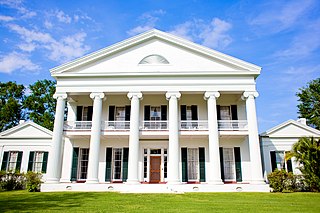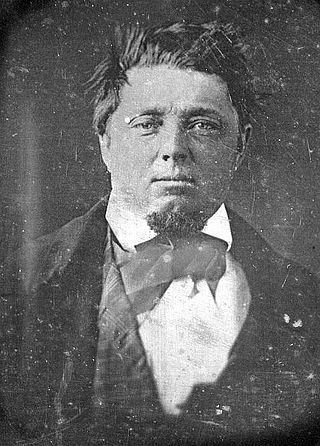
The Hermitage is a National Historic Landmark and museum located in Davidson County, Tennessee, United States, 10 miles (16 km) east of downtown Nashville in the neighborhood of Hermitage. The 1,000-acre (400 ha)+ site was owned by President Andrew Jackson, the seventh president of the United States, from 1804 until his death there in 1845. It also serves as his final resting place. Jackson lived at the property intermittently until he retired from public life in 1837.

Belle Meade Plantation, now officially titled Belle Meade Historic Site and Winery, is a historic farm established in 1807 in Nashville, Tennessee, built, owned, and controlled by five generations of the Harding-Jackson family for nearly a century. The farm, named "Belle Meade", grew to encompass 5,400 acres (22 km2) at its zenith and used a labor force of 136 enslaved workers. The farm's centerpiece was a Greek revival mansion built in 1853. Belle Meade Farm gained a national reputation in the latter half of the 19th century for breeding thoroughbred horse racing stock, notably a celebrated stallion, Iroquois. In the Civil War, when the Union Army took control of Nashville, the mansion was pillaged and looted by soldiers who spent weeks quartered there; the owner was imprisoned. In the aftermath, the plantation recovered, but with greatly reduced capacity. Roughly half of the enslaved persons returned as paid employees after the war and lived in their own homes nearby. After a financial downturn in 1893 and later the death of the owner and his heir, the estate was dismantled and sold in parcels in 1906.

Madewood Plantation House, also known as Madewood, is a former sugarcane plantation house on Bayou Lafourche, near Napoleonville, Louisiana. It is located approximately two miles east of Napoleonville on Louisiana Highway 308. A National Historic Landmark, the 1846 house is architecturally significant as the first major work of Henry Howard, and as one of the finest Greek Revival plantation houses in the American South.

Carnton is a historic plantation home built in 1826 in Franklin, Williamson County, Tennessee, United States. The property, comprising 1,420 acres (5.7 km2), played an important role during and immediately after the Battle of Franklin during the American Civil War. Carnton was situated less than one mile (1.6 km) from the location of the 1864 battle's Union Army eastern flank, and it became the principal temporary field hospital for tending the wounded. More than 1,750 Confederate soldiers lost their lives at Franklin, and on Carnton's back porch four deceased Confederate generals' bodies were laid out for a few hours after the battle. The life of Carrie McGavock, who lived at Carnton during the civil war, was the subject of a best-selling novel in 2005 by Robert Hicks, entitled The Widow of the South. The house was listed on the National Register of Historic Places in 1973, and became a museum managed by The Battle of Franklin Trust, a non-profit organization.

Belmont Mansion, also known as Acklen Hall, and originally known as Belle Monte, Belle Mont or Belmont, is a historic mansion located in Nashville, Tennessee. It was built by Joseph and Adelicia Acklen to serve as the center of their 180-acre summer estate in what was then country outside the city, and featured elaborate gardens and a zoo. They lived much of the rest of the year on her plantations in Louisiana.

Ardoyne Plantation House is located on Highway 311 in Schriever, Louisiana, just northwest of Houma, Louisiana. It was built 1894 and added to the National Register of Historic Places on November 1, 1982.

Adelicia Hayes Franklin Acklen Cheatham was an American planter and slave trader. She became the wealthiest woman in Tennessee and a plantation owner in her own right after the 1846 death of her first husband, Isaac Franklin. As a successful slave trader, he had used his wealth to purchase numerous plantations, lands, and slaves in Tennessee and Louisiana.

William Giles Harding was a Southern planter, attorney, and horse breeder who was made a Brigadier General in the Tennessee militia before the American Civil War. He took over operations of Belle Meade Plantation near Nashville from his father in 1839. During the course of his management, he acquired more property, expanding it from 1300 acres to 5,400 acres (22 km2) in 1860. He specialized in breeding and raising Thoroughbred horses, as well as other purebred livestock. In 1862 after Union forces took over Nashville, Harding was arrested as a leader and imprisoned at Fort Mackinac in northern Michigan on Mackinac Island for six months. He was released on a $20,000 bond. After being imprisoned at Fort Mackinac, he took the oath of allegiance to the Union and did not take an active part in the conflict from 1862 onwards.

Southdown Plantation is a historic Southern plantation in Terrebonne Parish, Louisiana.

The Clover Bottom Mansion is a historic mansion located in Nashville, Tennessee, United States. For 30 years it has been the home of the Tennessee Historical Commission, the State Historic Preservation Office.

Riverwood is a privately owned historic house located in Nashville, Tennessee, United States. At 9,200 square-feet it sits on 8 acres of its original 2,500 acres. It has been a wedding and event facility since 1997.

Colonel Van Perkins Winder was an American sugar planter in the Antebellum South.

The Polmer Store, built c. 1880, is a well-preserved example of the once-common plantation store, a type of company store used after slavery ended. The one-story frame structure in Terrebonne Parish, Louisiana, was added to the National Register of Historic Places in 1996.

Beech Grove is a historic mansion in Nashville, Tennessee. Built as a log house circa 1850, it was a Southern plantation with African slaves in the Antebellum era. In the 1910s, it became a livestock farm.

Belle Vue II is a historic mansion in Bellevue, a suburb of Nashville, Tennessee, USA. It was a Southern plantation worked by enslaved African Americans prior to the American Civil War of 1861–1865. After the war, it remained in the same family until the 1970s.

Skipwith Hall, also known as Skipwith Place, Oakwood Farm, Skipwith Harlan Hill, and Oakwood Hall, is a former plantation and plantation house located in Maury County, Tennessee. It was initially built by Edward Brinley Littlefield and Cornelia Lott Skipwith as their residence.
The Dixie Plantation is a Southern plantation with a historic house located in Franklin, Louisiana, USA.

Armitage is a historic house on a former plantation in Schriever, Louisiana, U.S.. It was built in 1852 for Francis L. Mead, who lived in the house until 1859, when it was purchased by Charles B. Armitage, his stepson-in-law. It was later acquired by Darden Roundtree, and inherited by his four sons. In 1948, it was purchased by Frank Wurzlow and his wife, and they restored it.

Mariah Bell Otey Reddick (1832–1922) was an American midwife, nurse, and domestic worker who was held as a slave at Carnton Plantation in Franklin, Tennessee. She worked for the family of Colonel John McGavock for four generations, both as a house slave and as a freedwoman. At Carnton, Reddick was the head of the household staff and also worked as a maid, nanny, and midwife for the family. During the American Civil War, she was sent to Montgomery, Alabama to stay at the home of Varina Davis' mother, Margaret Kempe Howell. During this time, she was employed as a nurse by the surgeon W.M. Gentry. After the war, Reddick was a favorite midwife of the women of Franklin's high society.

Caroline "Carrie" Winder McGavock was an American slave owner and the caretaker of the McGavock Confederate Cemetery at Carnton, a historic plantation complex in Franklin, Tennessee. Her life was the subject of a 2005 best-selling novel by Robert Hicks, entitled The Widow of the South.





















